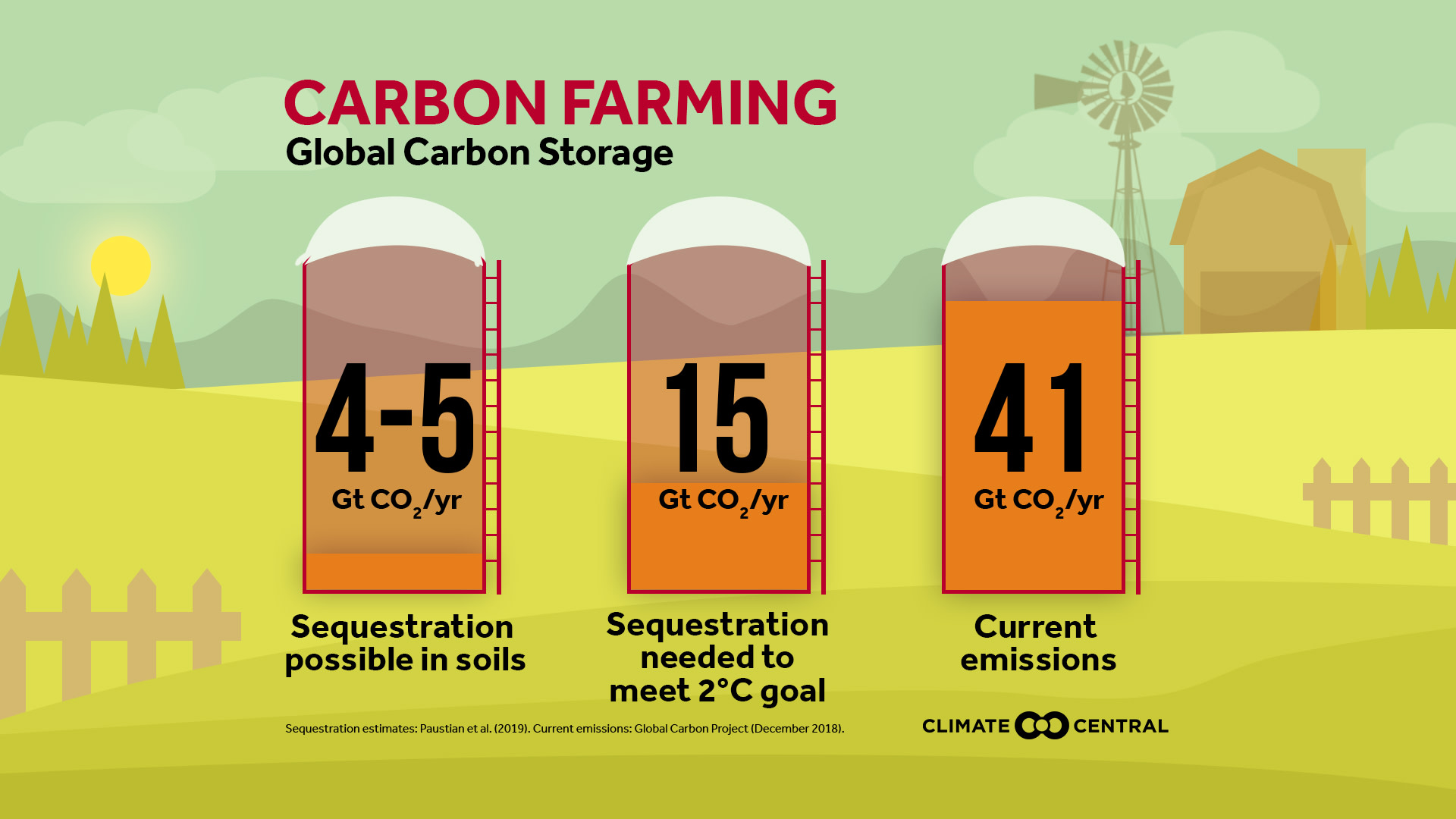KEY CONCEPTS
A peer-reviewed study in the journal Frontiers in Climate— co-authored by scientists from Climate Central and Colorado State University—highlights a series of “well-known, proven techniques” that can help offset carbon emissions and their impacts.
Best practices include composting (which adds carbon to the soil), reduced tilling (improves the soil’s ability to store carbon), and growing cover crops (limits runoff and erosion).
Nationwide, these sustainable techniques could store 200 million tons of CO2 per year—offsetting the annual emissions of 42 million passenger cars.
WHAT YOU NEED TO KNOW
Roughly 9% of U.S. greenhouse gas emissions relate to agriculture, from fertilizers to farm vehicles—not to mention the indirect impacts of livestock (yes, including cow burps).
According to a 2018 National Academies report, meeting the goals of the Paris Climate Agreement may require 15 gigatons of CO2 sequestration per year by 2100. Agricultural soils could provide up to a third of that—more than forest improvements and wetland restoration combined.
Healthy soils are the foundation of a healthy food system, and as we prepare for Thanksgiving, it’s a good time to acknowledge their power to produce sustaining and nutritious crops, and to mitigate climate change through carbon storage.
POTENTIAL LOCAL STORY ANGLES
How can I find out more about sustainable farming techniques and if they are happening in my area?
Sustainable Agricultural Research and Education (SARE), a non-profit program for independent farmers established by the USDA, maintains a library of sustainable farming resources, including research and decision tools, for topics like soil health, cover crops, and reducing climate risks to farming. You can search for local innovative sustainable farming projects in their state database.
The National Association of Conservation Districts, a non-profit representing 3,000 conservation districts across the country, has a number of soil health resources, including webinars and case studies, and a list of soil health champions across the country.
How can I evaluate the carbon footprints of local farms, vineyards, or ranches?
Colorado State University and the USDA’s Natural Resource Conservation Service support two interactive tools to evaluate potential greenhouse gas reductions through conservation practices.
COMET-Planner provides a generalized estimate of the equivalent tonnes CO2 reduced, localized by county and state.
COMET-Farm allows a user to evaluate a specific location and agricultural operation--including orchards, vineyards, cropland, or livestock. The tool asks for detailed information about past management practices, such as irrigation, tillage, planting and harvesting dates in order to produce an estimate that is tailored to the specific operation.
What about best practices for soils in urban areas?
The National Resources Conservation Service, has an urban soil primer and other resources for soil management practices in parks, urban farms, community gardens, green belts, and other suburban and urban locations.
LOCAL INTERVIEW IDEAS
The SciLine service,500 Women Scientists or the press offices of local universities may be able to connect you with local scientists or agricultural experts.
Talk to a local farmer: the USDA maintains directories for >farmers and community-supported agriculture (CSA) in your area—just type in your zip code. OR contact the rural development USDA office in your state.
ATTRA, a non-profit sustainable agriculture program, maintains a >searchable database of U.S. and Canadian sustainable agriculture grassroots groups, nonprofits, and agencies that is updated annually.
Search for your state’s department of agriculture at the National Association of State Departments of Agriculture.
NATIONAL INTERVIEW SUGGESTIONS
Keith Paustien>,
Distinguished Professor in the Department of Soil and Crop Sciences and Senior Research Scientist at the Natural Resource Ecology Laboratory at Colorado State University
Eric Larson>, Senior Scientist with Climate Central, Senior Research Faculty Member with the Energy Systems Analysis Group at Princeton University's Andlinger Center for Energy and the Environment.
Laura Bowling>, Professor, hydrology and water resources, Department of Agronomy, Co-director, Natural Resources & Environmental Sciences Program, Convener, Water Signature Research Area, Purdue Center for the Environment
HOW WE GOT THE DATA
Agricultural practices and associated carbon storage potentials are described by >Paustian et al. (2019) and Paustian et al. (2017). State totals have been aggregated from 2017 county-level estimates, with 2017 equivalences from the EPA Greenhouse Gas Equivalencies Calculator. The Global Carbon Project provides context for global emissions.
